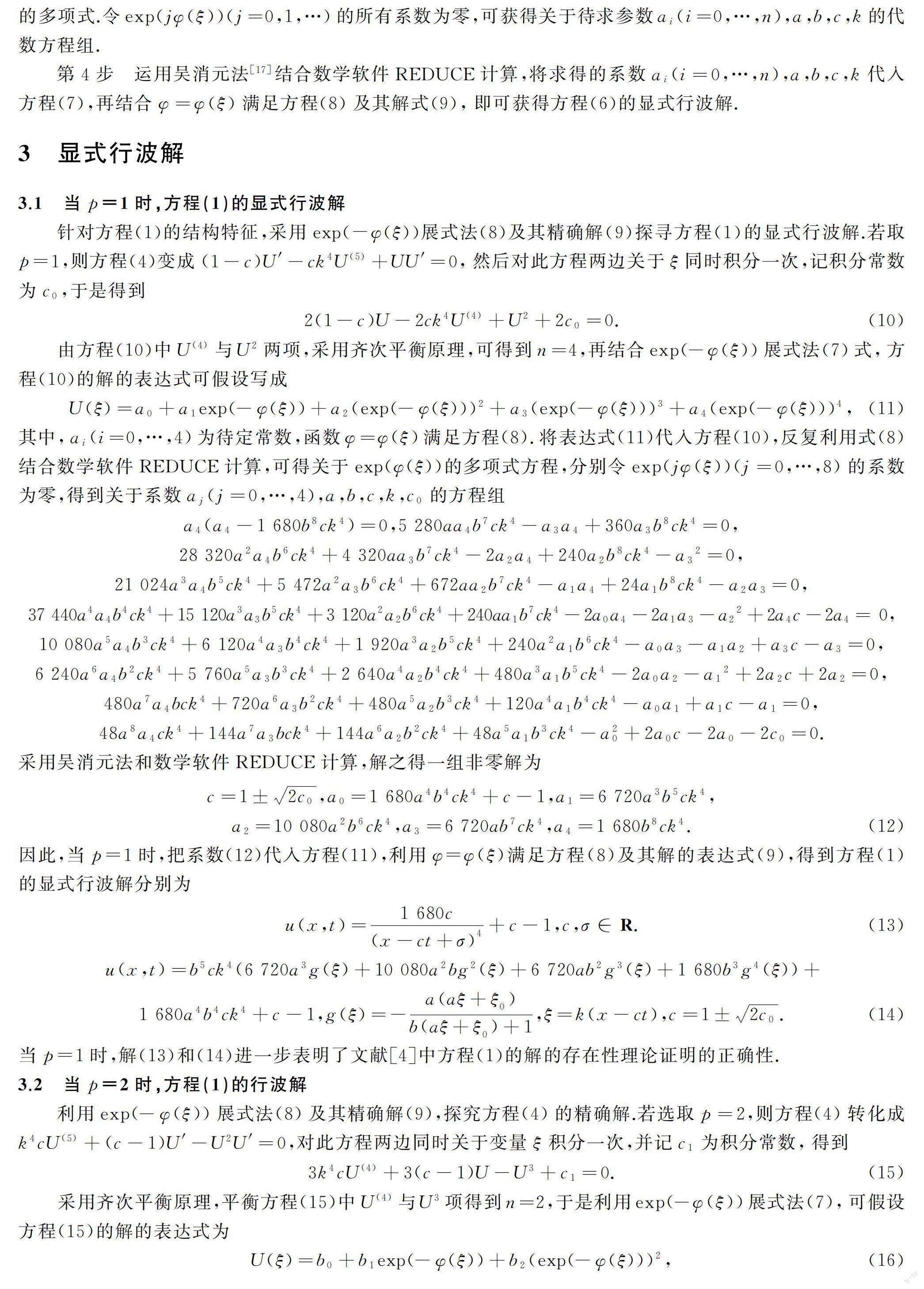Rosenau方程的显式行波解及动力学行为
林府标 杨欣霞 张千宏



摘 要:找到Rosenau方程的顯式精确解十分困难,研究方法常采用数值离散求解技术.首先,采用李群分析法给出了Rosenau方程的对称群、约化常微分方程和群不变解;其次,构造了一种精确求解非线性偏微分方程的exp(-φ(ξ))展式法,利用此方法找到了Rosenau方程的显式行波解,分析了解的动力学行为;最后,所获得的显式行波解既证明了Rosenau方程显式精确解的存在性,又可用于验证数值解的精度、检验数值离散方案的优劣,为工程领域的实际应用提供理论依据和参考.
关键词:Rosenau方程;显式行波解;动力学行为
中图分类号:O175.4;O175.29文献标志码:A文章编号:1000-2367(2024)02-0033-08
在探究离散系统稠密性的动态性时,为了克服KdV方程不能准确预测坡度和高振幅波性态的缺点,ROSENAU[1-2]提出了五阶非线性偏微分Rosenau方程
Lu= ut+uxxxxt+ux+upux=0, (1)
其中,t表示时间,x代表平衡水平面上沿波传播方向上的坐标,p为非零常数.当p=1时,方程(1)称为Rosenau方程,当p≠1时,方程(1)称为广义Rosenau方程.为了进一步考虑动力学系统中非线性波及耗散现象,PARK[3]讨论了含黏性项-uxx的Rosenau-Burgers方程
ut+uxxxxt-μuxx+ux+uux=0 (2)
的解的存在性和唯一性,其中,μ代表非负黏性系数.方程(1)和(2)在研究紧离散动力学系统、 模拟无线电及计算机领域、 波与波相撞、波与障碍物或墙相互作用等方面具有重要应用.但鉴于方程(1)和(2)精确解的缺乏,初值和边值问题解的存在唯一性、 柯西问题的适定性、 算法的收敛性和稳定性、误差估计、解的渐近性、永久性、动力学行为性质等常借助于数值离散及实验技术进行研究[4-13].
虽然历经多年的研究和探索,构造非线性偏微分方程的精确解,已找到了许多方法与技巧[14],如李群分析法[15],Tanh函数法和广义Tanh函数法[14],齐次平衡法[14,16]等.但鉴于诸多新方程不断从各个学科领域中涌现,在非线性科学和工程技术领域,至今仍然存在众多的方程很难找到精确解[14].就现有文献[1-13]来看,寻求方程(1)和(2)的精确解及方法,仍是一个亟待探索和解决的问题.
论文拟不仅对方程(1)和(2)作经典李群分析,而且构造一种精确求解非线性偏微分方程的exp(-φ(ξ))展式法.针对方程(1)的结构和特征及性质,利用此方法探索方程(1)的显式行波解及孤立波解.对找到的行波解,分析解的相关动力学行为及性质.希望所获得的解可用于验证数值解的正确性和精度,以及检验数值离散方案的优劣,也为精确描述、解释、模拟及应用许多自然科学现象提供理论依据和策略.
1 李群分析法
2 exp(-φ(ξ))展式法
3 显式行波解
4 解的动力学行为
5 结束语
找到了方程(1)和(2)的对称群和群不变解.构造了一种精确求解非线性偏微分方程的exp(-φ(ξ))展式法.采用该方法获得了方程(1)的行波解,文献[1-13]均未报道过这些解.找到的解表明了文献[4]中方程(1)的解的存在性理论证明的正确性,而且对进一步研究和寻找方程(1)的精确解,既有理论价值又有实际意义,也为数值解提供了理论依据和参考.构造的exp(-φ(ξ))展式法可用于求解其他非线性偏微分方程,如广义Rosenau方程ut+αux+βxxxxt+γpux=0,变系数的Burgers方程ut+αuxx+βux=0和KdV方程ut+αuxxx+βux=0,其中α,β,γ,p为常数.如何构造行之有效的精确求解方法,挖掘出方程(1)和(2)中蕴藏着的更多类型的精确解,值得在今后的研究中进一步探索和创新.
参 考 文 献
[1]ROSENAU P.A quasi-continuous description of a nonlinear transmission line[J].Physica Scripta,1986,34:827-829.
[2]ROSENAU P.Dynamics of dense discrete systems high order effects[J].Progress of Theoretical Physics,1988,79(5):1028-1042.
[3]PARK M A.On the Rosenau equation in multidimensional space[J].Nonlinear Analysis:Theory,Methods & Applications,1993,21(1):77-85.
[4]PARK M A.On the Rosenau equation[J].Computation and Applied Mathematics,1990,9:145-152.
[5]ZHOU D Q,MU C L.Control and stabilization of the Rosenau equation posed on a periodic domain[J].Journal of Systems Science and Complexity,2018,31(4):889-906.
[6]SHI D Y,JIA X.Nonconforming Quasi-Wilson finite element approximation for the nonlinear Rosenau equation[J].Applied Mathematics Letters,2021,119:1-8.
[7]ERBAY H A,ERBAY S,ERKIP A.Numerical computation of solitary wave solutions of the Rosenau equation[J].Wave Motion,2020,98:1-10.
[8]何挺,胡兵,徐友才.广义Rosenau方程的有限元方法[J].四川大学学报(自然科学版),2016,53(1):1-6.
HE T,HU B,XU Y C.Finite element method for the generalized Rosenau equation[J].Journal of Sichuan University (Natural Science Edition),2016,53(1):1-6.
[9]WANG M,LI D S, CUI P.A conservative finite difference scheme for the generalized Rosenau equation[J].International Journal of Pure and Applied Mathematics,2011,71(4):539-549.
[10]HUSSAIN M,HAQ S.Numerical simulation of solitary waves of Rosenau-KdV equation by Crank-Nicolson meshless spectral interpolation method[J].The European Physical Journal Plus,2020,135(98):1-22.
[11]高启存,阿不都热西提·阿布都外力.非齐次Rosenau-Burgers方程的三种数值方法比较[J].数学的实践与认识,2021,51(6):246-256.
GAO Q C,ABUDUREXITI A.Comparison on the three numerical methods for nonhomogeneeous Rosenau-Burgers equation[J].Mathematics in Practice and Theory, 2021,51(6):246-256.
[12]OMRANI K,DEBEBRIA H,BAYARASSOU K.On the numerical solution of two-dimensional Rosenau-Burgers (RB) equation[J].Engineering with Computers,2020:827-829.
[13]ZHANG J,LIU Z X,LIN F B,et al.Asymptotic analysis and error estimate for Rosenau-Burgers equation[J].Mathematical Problems in Engineering,2019,1-8.
[14]范恩贵.可积系统与计算机代数[M].北京:科学出版社,2004.
[15]OVSIANNIKOV L V.Group Analysis of Differential Equations[M].New York:Academic Press,1982.
[16]WANG M L,ZHOU Y B,LI Z B.Application of a homogeneous balance method to exact solutions of nonlinear equations in mathematical physics[J].Physics Letters A,1996,216(1-5):67-75.
[17]吴文俊.数学机械化[M].北京:科学出版社,2003.
Explicit travelling wave solutions and dynamic behaviors of the Rosenau equation
Lin Fubiao, Yang Xinxia, Zhang Qianhong
(School of Mathematics and Statistics, Guizhou University of Finance and Economics, Guiyang 550025, China)
Abstract: It is typically difficult to obtain explicit exact solutions of the Rosenau equation, it was usually intensively investigated by use of the numerical schemes and techniques. Firstly, symmetric groups, reduced ordinary differential equations and group invariant solutions of the Rosenau equation were given by the method of classical Lie group analysis. Secondly, an exp(-φ(ξ))-expansion method for solving analytically nonlinear partial differential equation was constructed. Moreover, explicit travelling wave solutions of the Rosenau equation were found by using the exp(-φ(ξ))-expansion method, the corresponding dynamic behaviors of solutions were also analyzed. Finally, on the one hand, the existence of solutions of the Rosenau equation was demonstrated by these obtained explicit travelling wave solutions. These obtained exact solutions can be used to verify accuracy of numerical solution, test advantages and disadvantages of numerical discrete scheme, and study dynamic behaviors of solutions. In addition, it also provides a theoretical basis for the practical application in the field of engineering.
Keywords: Rosenau equation; explicit travelling wave solution; dynamic behavior
[責任编校 陈留院 赵晓华]

